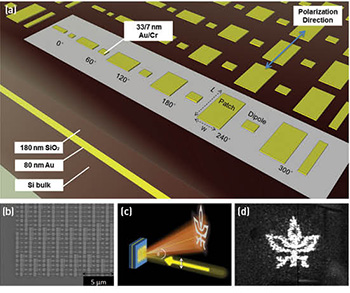 (a) Coupled patch-dipole nano-antennas, fabricated over a gold backreflector and a SiO2 buffer layer, are designed to span the phase at 60° intervals. (b) SEM image of fabricated array. (c) In the experimental setup, a linearly polarized laser beam is directed toward the nano-antenna array and projects a highly efficient hologram toward a wide angle. (d) Infrared image of the resulting hologram, projected to 45°.
(a) Coupled patch-dipole nano-antennas, fabricated over a gold backreflector and a SiO2 buffer layer, are designed to span the phase at 60° intervals. (b) SEM image of fabricated array. (c) In the experimental setup, a linearly polarized laser beam is directed toward the nano-antenna array and projects a highly efficient hologram toward a wide angle. (d) Infrared image of the resulting hologram, projected to 45°.
As a route to genuine 3-D projection, with applications in medicine, design and entertainment, holography has captured the public imagination since its inception in the late 1940s.1 Most contemporary, computer-generated holograms rely on transmitting light waves through a transparent medium of varying thickness or refractive index. The slight changes in the optical path translate into changes in the wave’s phase front, which allows, in principle, for the generation of beams with arbitrary profiles. But the phase resolution of these elements is limited by fabrication methods and shading effects, and the resulting holograms show low efficiency and narrow angular coverage.
Nano-antennas are natural candidates for highly efficient holography. In recent years, researchers have demonstrated the use of coupled nano-antenna structures for controlling the optical phase of light in a wide range of applications, such as lensing and complex waveform generation.2 Yet most recent studies have focused on the transmission mode, and thus efficiencies—the fraction of the impinging power that is channeled into the hologram—have remained low.
We have now demonstrated phase front shaping and holography using patch-dipole nano-antennas.3 These elements, fabricated over a gold backplane reflector and a SiO2 buffer, yield dramatic improvement in hologram efficiency. Moreover, our design method, based on optimization of the nano-antennas in groups rather than (as in previous work) individually, reduces the power scattered into spurious beams, boosting the efficiency still further.
We have demonstrated the strength of this approach by designing and fabricating an array of nano-antennas that generates a hologram and projects it at wide angles of 20 and 45 degrees relative to the impinging beam. The Gerchberg-Saxton algorithm4 allowed us to determine the required phase map, which we realized by writing the appropriate antenna at each position using electron beam lithography. The efficiency of the hologram in the range of 1,440 to 1,640 nm exceeded 40 percent at both angles.
Our approach can apply to any wavelength range and can be used for generating an arbitrary, high-efficiency, omnidirectional hologram. The next step is incorporating techniques to activate the antennas, to allow for dynamic holography and beam-steering.
Researchers
Yuval Yifat, Michal Eitan, Zeev Iluz, Yael Hanein, Amir Boag and Jacob Scheuer, Tel Aviv University, Tel Aviv, Israel
References
1. D. Gabor. Nature 161, 4098 (1948).
2. N. Yu et al. Science 334, 6054 (2011).
3. Y. Yifat et al. Nano Lett. 14, 5 (2014).
4. R. Gerchberg et al. Optik 35, 237 (1972).
